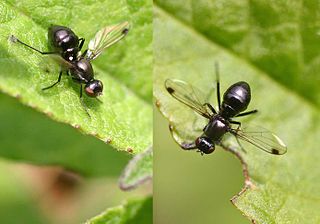
The Sepsidae are a family of flies, commonly called the black scavenger flies or ensign flies. Over 300 species are described worldwide. They are usually found around dung or decaying plant and animal material. Many species resemble ants, having a "waist" and glossy black body. Many Sepsidae have a curious wing-waving habit made more apparent by dark patches at the wing end.

The Ulidiidae or picture-winged flies are a large and diverse cosmopolitan family of flies (Diptera), and as in related families, most species are herbivorous or detritivorous. They are often known as picture-winged flies, along with members of other families in the superfamily Tephritoidea that have patterns of bands or spots on the wings. Some species share with the Tephritidae an unusual elongated posteroapical projection of the anal cell in the wing, but can be differentiated by the smoothly curving subcostal vein. Two species, Tetanops myopaeformis and Euxesta stigmatias, are agricultural pests.

The Lauxaniidae are a family of acalyptrate flies. They generally are small flies with large compound eyes that often are brightly coloured in life, sometimes with characteristic horizontal stripes, such as in Cestrotus species. Many species have variegated patterns on their wings, but in contrast they generally do not have variegated bodies, except for genera such as Cestrotus, whose camouflage mimics lichens or the texture of granitic rocks.

The Chamaemyiidae are a small family of acalyptrate flies with less than 200 species described worldwide. The larvae of these small flies are active and predatory and are often used for biological control of aphids, scale insects, and similar pests. Chamaemyiid fossils are poorly represented in amber deposits, but a few examples are known from the Eocene epoch onwards.
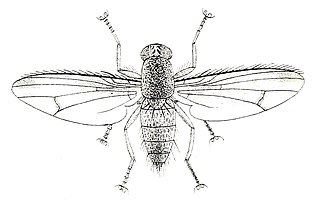
The Curtotonidae or quasimodo flies are a small family of small grey to dark brown humpbacked flies (Diptera) with a worldwide distribution, but with very few species in the Nearctic, Australasian/Oceanian, and Palaearctic regions. Most members of the family are found in tropical to subtropical latitudes in Africa and the Neotropics. Many remain undescribed in collections, since little work on the family has been done since the 1930s.

The Tanypezidae, known as the “stretched-foot flies”, are small family of acalyptrate Diptera. The 28 species are found mostly in the New World, divided between two genera: Tanypeza is found in North America, with the type species extending into the Palaearctic, and Neotanypeza is neotropical in distribution and includes one species known only from Dominican amber from 17 to 20 million years ago, N. dominicana Lonsdale & Apigian. This distribution contrasts that of its sister family, the Strongylophthalmyiidae, which is mostly East Asian in distribution.
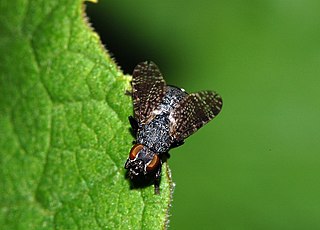
The Platystomatidae are a distinctive family of flies (Diptera) in the superfamily Tephritoidea.

The Pyrgotidae are an unusual family of flies (Diptera), one of only two families of Cyclorrhapha that lack ocelli. Most species are "picture-winged", as is typical among the Tephritoidea, but unlike other tephritoids, they are endoparasitoids; the females pursue scarab beetles in flight, laying an egg on the beetle's back under the elytra where the beetle cannot reach it. The egg hatches and the fly larva enters the body cavity of the beetle, feeding and eventually killing the host before pupating. In the United States, some species of Pyrgota and Sphecomyiella can be quite common in areas where their host beetles are abundant. Like their host beetles, these flies are primarily nocturnal, and are often attracted to artificial lights.

Urophora is a genus of tephritid or fruit flies in the family Tephritidae.
Spheginobaccha is a genus of hoverflies, with 15 known species. The genus is readily separated from other microdons by the incomplete metathoracic bridge, round/oval basoflagellomere, occiput with a dorsolateral crease, and other characters.
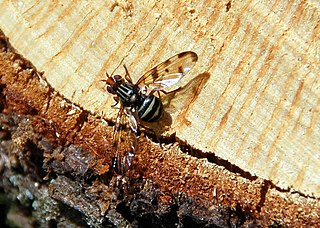
Otitinae is the name of a subfamily of flies in the family Ulidiidae. It was formerly the Otitidae. Like the Ulidiinae, most species are herbivorous or saprophagous. Most species share with the Tephritidae an unusual elongated projection of the anal cell in the wing, but can be differentiated by the smoothly curving subcostal vein. Most are dull gray to shiny brown or black flies with vein R1 setulose or, in a few cases, bare.

Platystomatinae is a subfamily of flies (Diptera) in the family Platystomatidae that includes 80 genera, the largest subfamily with at last estimate, c. 900 species globally.

Tethina is a genus of beach flies in the family Canacidae. They are found in all terrestrial biogeographic realms.

Tephritini is a tribe of fruit flies in the family Tephritidae. There are about 80 genera and some 1000 described species in Tephritini.
Aphasmaphleps is a genus of flies in the family Dolichopodidae from the Afrotropical realm. The genus was first described by Igor Grichanov in 2010. The name Aphasmaphleps refers to the genus Phasmaphleps, which was originally considered to be closely related to it. According to Capellari & Grichanov (2012), Aphasmaphleps more closely resembles Asyndetus and Cryptophleps.

Sciomyzinae is a subfamily of flies in the family Sciomyzidae.
Natalimyza is a genus of flies placed in the family Natalimyzidae and known as African grass flies. There are about 30 species in Africa which are found mainly in grasslands where their larvae are thought to feed on decaying plant material. They are small yellow to brown and appear like flies in the families Chyromyidae or Opomyzidae, but differentiated by bristles on the head, having four fronto-orbital bristles.
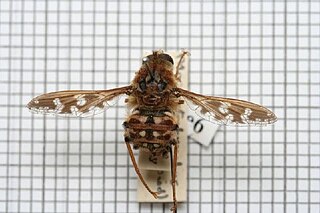
Moegistorhynchus is a genus of tangle-veined flies in the family Nemestrinidae. It was described in 1840 by Pierre-Justin-Marie Macquart.

Moegistorhynchus longirostris is a keystone species of fly that lives on the west coast of South Africa.















